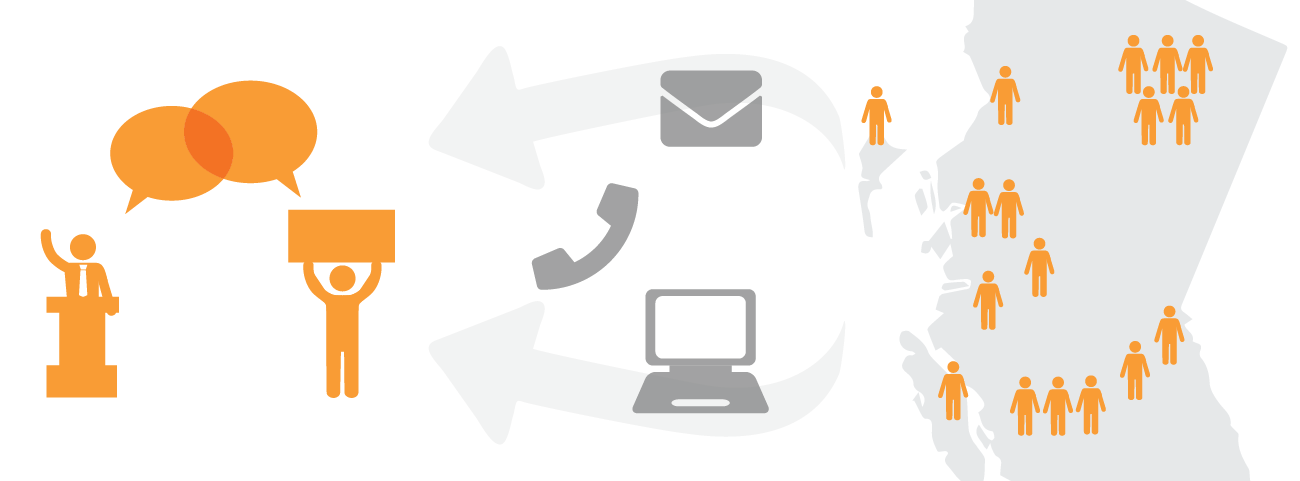Adding your voice to the conversation
There are many ways for you to reach out to your local MLA, whether it’s via email, on social media, or in person. To make it easy for you, Pain BC has put together several ideas and resources – including a letter template you can use, pain facts, suggested social media posts, and contact information below.
Getting in touch with your MLA
Send an email or a letter (or both!)
Not sure what to say? You can download and customize Word Document letter template we’ve created (or view and save the PDF version) to contact your MLA via email or letter. You can copy and paste the content, but we encourage you to personalize it by adding why this issue is important to you!
Use the power of social media
Most MLAs use social media so, if you are too, then consider sending a Tweet or posting a public Facebook message. If you normally keep your social media posts private, consider setting these types of posts to be public so that it can be shared far and wide.
Call or visit your constituency office
You can also call or visit your MLA's constituency office to raise your concerns, ask questions, and ask for support for those living with pain. Be sure to tell the office volunteer you’d like a response to your questions, and ensure they have your correct contact details.
Spread the word and get others to support people in pain
The more we can bring chronic pain to the forefront, the more we can push for better supports and services for those living with pain. Encourage friends, family, staff, colleagues, and your community to reach out.
Contact details for your MLA
- Find the contact information for your current MLA via the Legislative Assembly website
Facts about pain and its impacts on British Columbians
You can use these facts about chronic pain in your message to your MLA.
- 22% of the population in British Columbia lives with chronic pain; the skepticism and stigma around chronic pain can cause feelings of extreme isolation, frustration, and hopelessness. Unsurprisingly, people with chronic pain are four times as likely to live with depression and anxiety and two times as likely to attempt suicide as the general public[1].
- More than a symptom of an underlying health problem, chronic pain is a disease in its own right. People living with chronic pain often seem “fine” to family, friends, and health care providers because pain is usually invisible.
- Direct health care costs for chronic pain in Canada are estimated at over $6 billion per year, with annual productivity costs related to job loss and sick days at $37 billion[2].
- Chronic pain is the most common reason for seeking health care; it leads to an average of 10 GP visits a year vs. the national average of 3.8 visits.
- 28% of ER visits are due to chronic pain and chronic pain leads to 2 times more hospital visits.
- People living with chronic pain are at risk of losing their employment and their housing, eventually slipping into poverty and isolation.
- 65% of seniors in the community experience chronic pain; estimates are as high as 80% for seniors living in care facilities.
- Pain disproportionately impacts vulnerable populations (e.g. those with mental health issues or addictions).
- Untreated pain can be a gateway to addiction and mental health issues.
- Some people in pain are being negatively impacted by a pendulum swing away from prescribing opioids for pain and some are turning to the street for relief, with the potential for overdose and death.
- Veterinary students in Canada get 2 to 5 times more pain management education than medical students do.
- Pain is recognized as a biopsychosocial problem that requires a biopsychosocial approach to treatment and care.
- Prevention and early intervention are essential to improving outcomes and limiting pain-related disability.
By raising our voices, together we can change pain in BC!
[1] http://www.phac-aspc.gc.ca/publicat/ebic-femc/2005-2008/assets/pdf/ebic-femc-2005-2008-eng.pdf
[2] Pain Costing from Gaskin, DJ, Richard P. J Pain 2012; 13(8):715-724; Economic Burden of Illness in Canada Report 2005-2008 (last available)
